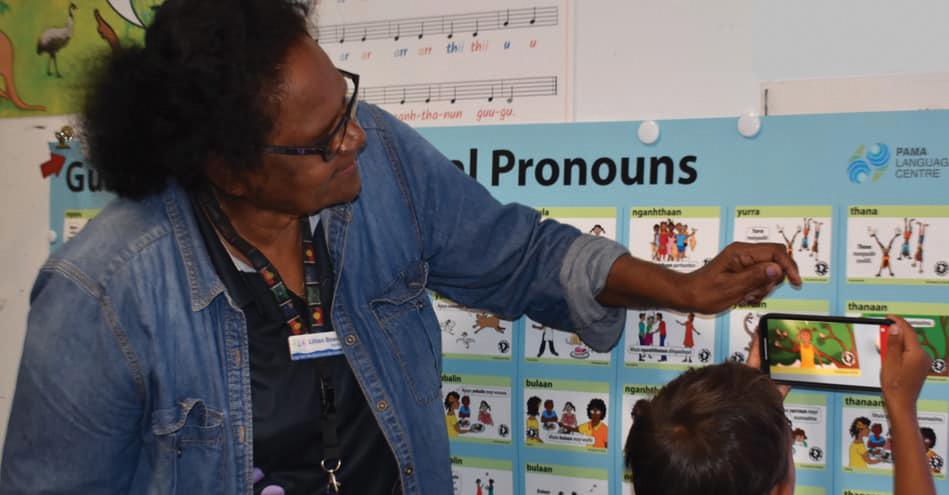
14 minute read
Pama Language Centre
OVERVIEW
Pama Language Centre (PLC) is ensuring the viability of ancestral languages in Cape York Peninsula by:
Advertisement
• working with speakers to record the linguistic and cultural detail of their First Nations languages • working with speakers to increase and promote literacy in First Nations languages through developing contemporary literature and language learning materials • working with speakers to revive intergenerational transmission of their languages • raising awareness and support for the First Nations languages of Cape York Peninsula in the wider community.
THE ROAD TO ANCESTRAL LANGUAGE VIABILITY
Recording of languages and active corpus development with speakers begins
Linguists work with speakers to create opportunities for language transmission and promotion Speakers engage in authorship at many levels, taking control of the future of their ancestral languages
Viability of language is assured by completion of recording and ongoing corpus development. Intergenerational transmission continues to increase.
PLC is an initiative of the Cape York Institute, established to pursue the right of all children of Cape York Peninsula’s First Nations to be fluent and literate in their ancestral languages so that they can walk with confidence in two worlds, as the inheritors of their rich, living cultural heritage. PLC supports recording, revitalisation, revival and maintenance activities with both local speech communities and diaspora for: Injinoo Ikya language including Yadhaykenu First Nation; Atambaya First Nation and Angkamuthi First Nation; the Anguthimri languages including Mpakwithi First Nations; Thaynakwith First Nation; Warrangu First Nation and Tjugudji First Nation; Wik-Mungkan, Wik-Alken/Wik-Ngatharr and Wik-Ngathan First Nations; Guugu Yimithirr First Nation; Kalaw Kawaw Ya First Nation; Kulkalgaw Ya First Nation and the Southern Kaantju First Nation. PLC continues to seek funding and partners to enable the extension of language support to all First Nations of Cape York.
PARTICIPATION AND REACH
ESTIMATED MEMBERSHIP OF LANGUAGE NATIONS CURRENTLY SERVED BY PLC
750 Injinoo Ikya, Atambaya, Angkamuthi, Yadhaykenu 60 Anguthimri, Mpakwithi, Thaynakwith, Tjugundji 1,200+ Wik-Mungkan 50 Wik-Alken 50 Wik-Ngatharr 80 Wik-Ngathan 1,200 Guugu Yimithirr 50 Uw Olgol and Oykangand 36 Southern Kaantju 300 Kulkalgaw Ya 1,000 Kalaw Kawaw Ya 39+ Kugu Nganhcarra 24 Warranggu NUMBER OF SPEAKERS INVOLVED IN PLC ANCESTRAL LANGUAGE ACTION TEAMS AND LEARNING HUBS
129 speakers participated in recording, revitalisation, revival and maintenance work between January and June, including:
16 Injinoo Ikya
5 Mpakwithi
3 Wik-Mungkan
104 Guugu Yimithirr
1 Warranggu
129
Participating Speakers
20+
Language Nations currently served
NUMBER OF SPEAKERS AND NON-SPEAKERS DIRECTLY REACHED BY OR INVOLVED IN PLC ACTIVITIES
106 children at Cape York Aboriginal Australian Academy (CYAAA) Hope Vale campus and 100+ adult speech community members are benefitting from the outputs of Guugu Yimithirr song-writing, choir and recording workshops, as well as from recording initiatives, return of materials from the Australian Institute of Aboriginal and Torres Strait Islander Studies (AIATSIS), and the availability of Guugu Yimithirr language materials. 3,000 Northern Peninsula Area (NPA) people continue to benefit from the availability of the first recording of Injinoo Ikya language hymns, children’s picture books in Mpakwithi, body parts poster books in Injinoo Ikya languages and animated video clips of children’s songs in Mpakwithi and Injinoo Ikya. The New Mapoon community is also benefitting from the ‘Voices of Old Mapoon’ healing process and song-writing workshops. 60 members of the Anguthimri community are benefitting from the composition of songs and learning resources at the ‘Voices of Old Mapoon’ Healing Camp, and the availability of children’s books. 1,889 visitors to PLC’s Thudaan Diini (Red Road) early childhood series YouTube channels have benefitted from regular Guugu Yimithirr immersion. 170+ students at Aurukun State School benefit from the availability of Wik-Mungkan children’s songs, video clips and learning resources. 30 members of the Guugu Yimithirr and Anguthimri diaspora benefit from online teaching materials and weekly online classrooms. 16 members of the Injinoo Ikya, Angkamuthi, Yadhaykenu and Atambaya speech communities benefit from regular language intensives and teaching resources. 1 Kalaw Kawaw Ya community member is currently working with PLC on the development of the first published resources in Kalaw Kawaw Ya. 102 total subscribers and 430 (approx.) visitors per month to PLC’s YouTube channel benefit from song clips and learning resources in First Nations languages. Up to 200 visitors per day benefit from information and resources on PLC’s website.
HOW DOES THE PLC SUPPORT LANGUAGE REVITALISATION?
LANGUAGE RECORDING
PLC salvages existing language information, including linguistic detail and oral literature, so that it can be preserved into the future. A significant amount of linguistic detail and oral traditions remain to be recorded in Cape York Peninsula, however, this work needs to be done quickly to keep Cape York languages and cultures rich and viable. CORPUS EXPANSION
PLC helps First Nations languages to conquer domains previously dominated by English via the development of new genres, such as children’s literature and songs, poetry and theatre. This helps speakers think and talk about new ways to say things and new ways to use their beautiful First Nations languages.
Intergenerational transmission is the internationally-recognised measure of language strength and language endangerment. For many Cape York Peninsula languages, parents are no longer able to speak their language fluently and confidently with their children. PLC works to create opportunities to revive the flow of First Nations language transmission to younger generations.
OVERVIEW OF PLC’S ACTIVITIES, JANUARY–JUNE 2021
JANUARY/ FEBRUARY MARCH APRIL MAY
Animated film clip in Yadhaykenu— Apudthinngal Wuchuma (The three brown snakes) was uploaded to YouTube. First episode of Tava Ghwa (Sandy Road)— Mpakwithi immersion series was aired on YouTube. Membership of the Guugu Yimithirr Online classroom increased to include a new diaspora member.
First episode of season two of Thudaan Diini (Red Road) aired on YouTube. Sacred Creations Dance and PLC collaborated to develop an animated backdrop and story for an upcoming multi-media performance at the Indigenous Cultural Festival. Music and voice-overs were also recorded. A book of graded exercises to support the learning of Guugu Yimithirr kinship terms was produced by PLC. PLC’s first Injinoo Ikya language intensive was held in Bamaga, NPA. PLC facilitated the first in the 2021 series of ‘Voices of Old Mapoon’ wellbeing workshops in Bamaga. An animated augmented reality version of Biniirr Bama Yuwalin (Ironwood Family at the Beach) was published by PLC. PLC participated in the Pacific Consultations for the preparation of the Global Action Plan for the International Decade of Indigenous Languages 2022/2032.
JUNE
Milbi Ngutha-nguthangan (Stories from a long time ago) was performed at the Indigenous Cultural Festival in Cooktown. CYAAA Guugu Yimithirr Language Teacher, Lillian Bowen and her students composed new songs in Guugu Yimithirr during Songs on Country workshops in Hope Vale. PLC completed a read-aloud e-book of Biniirr Bama Yuwalin (Ironwood Family at the Beach). PLC published an augmented reality Guugu Yimithirr alphabet poster. A Guugu Yimithirr picture book by Madge Bowen was published by PLC. Guugu Yimithirr children’s books by Irene Hammett and Lillian Bowen were sold at the PLC bookstall at the Cooktown 2021 Expo.
POSITIVE OUTCOMES AND IMPACTS
PLC =
increased engagement with ancestral languages (speakers are excited to have the opportunity to work with their languages) increased accessibility of ancestral languages increased viability of ancestral languages an increased sense of anticipation and investment in the future
PLC WORKS TO CREATE A HEALTHY SPIRAL OF LANGUAGE REVITALISATION
Thorough language documentation and corpus expansion is critical to the viability of languages. These processes also have many positive ‘spin-offs’ that feed back into increased viability of the language and speech community, into individual wellbeing, identity belonging, improved educational aspirations and outcomes. • Awareness • Expectation • Engagement with language • Engagement with other spheres • Collaborative action and responsibility • Planning for the future • Working with language inspires innovative thinking and cooperative action.
2025
and beyond…
2015
WE AIM TO ACHIEVE:
Viability of Cape York Peninsula languages Core language resources developed Intensive documentation and corpus development
THE USE OF TECHNOLOGY IN SAVING THREATENED LANGUAGES
USING AUGMENTED REALITY FOR LANGUAGE IMMERSION
Cape York Peninsula is a world hotspot of language diversity, with more than 150 language varieties. Most fluent speakers of these languages are of the grandparental generation. Due to Cape York’s history of violence against the First Nations Peoples, as well as current imperatives of work and education, the Cape York diaspora now extends across Australia and beyond. This context creates many challenges for language revitalisation as, for most of Cape York languages, natural transmission has all but broken down and the important contexts in which language transmission usually occurs, the home and village, are no longer naturally immersive language learning environments.
Full immersion contexts for natural language transmission cannot be rebuilt overnight, so PLC works to develop approximations to fill the gap—harnessing traditional knowledge, best practice language pedagogy and modern technology, such as augmented reality (AR).1 These exciting, immersive learning resources turn homes and school rooms into active language learning environments, enabling and encouraging young parents, children, language teachers and students to both actively study and reengage naturally with their languages. Guugu Yimithirr Language teacher and champion Lillian Bowen OAM says these resources are:
During January–June, new AR resources were completed by PLC to support both the Guugu Yimithirr classroom at the Hope Vale campus of CYAAA and the diaspora language learners. These included Lillian Bowen’s new illustrated children’s book, Biniir Bama Yuwalin (Ironwood Family at the Beach), which contains animated AR layers on each page with beautiful Guugu Yimithirr audio recorded by Lillian with her family. A read-aloud e-book, which is linked to the printed book via a scannable zap code, was also completed.
A new Guugu Yimithirr interactive AR alphabet poster was also created, which includes spoken Guugu Yimithirr narrating each of the 21 letters of the Guugu Yimithirr alphabet in a full sentence. The associated Guugu Yimithirr alphabet book contains the Guugu Yimithirr alphabet song and links to additional resources.
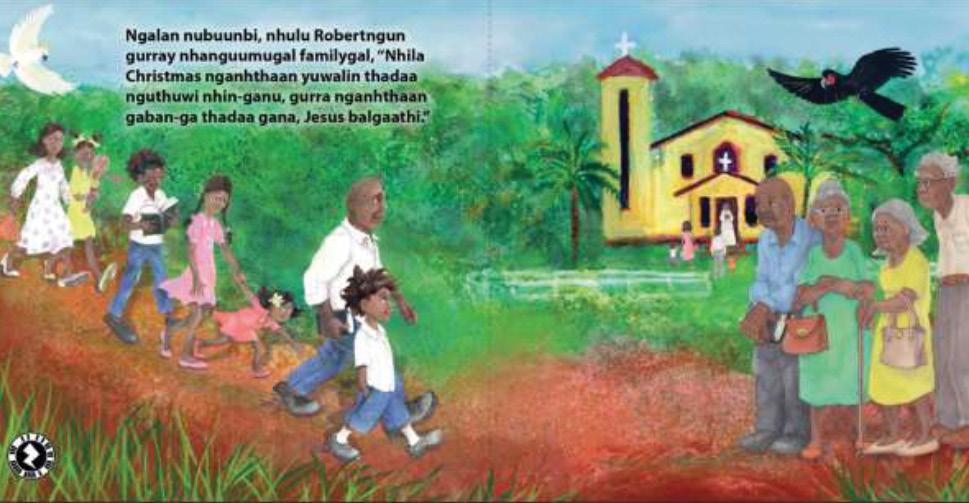
Each page of Lillian Bowen’s new illustrated children’s book, Biniir Bama Yuwalin (Ironwood Family at the Beach), animates with high quality audio in Guugu Yimithirr after scanning the zap with the zappar app, which can be downloaded free from the app store.
1 Total Physical Response (TPR) is a method of teaching language or vocabulary concepts by using physical movement to react to verbal input. It mimics the way that infants learn their first language, and aims to create a brain link between speech and action to boost language and vocabulary learning.
BRINGING INJINOO IKYA BACK INTO EVERYDAY LIFE
In May, a four-day Injinoo Ikya language intensive was delivered by PLC Linguist Xavier Barker, with funding support by the Ely Charitable Trust. Feedback on the class, held at Bamaga TAFE, was positive with participants enjoying the new learning resources and language learning approaches that were piloted, including Total Physical Response1 with puppets.
Lessons were co-presented by passionate Elders Charlie and Millie who are Injinoo Ikya monolinguals unable to speak English. Interactive AR home signage was also provided and demonstrated to the class. The idea behind the interactive signage is to begin to bring Injinoo Ikya language back into the home and everyday life and to provide ongoing opportunities to hear and engage with the language.
Many of the students who attended brought children with them, so this was a truly multi-generational and lively language transmission experience. Three further Injinoo Ikya intensives are scheduled later in 2021. Participants like Angkamuthi man George Ropeyarn expressed the hope that this important initiative will continue beyond 2021, as an invaluable support for the revitalisation of his ancestral language.

Participants in the Injinoo Ikya language class scanned augmented reality language learning resources with their mobile phones.
“Government policy took our languages away from us, the Injinoo-kuchinu, but through our collaboration with Pama Language Centre, we are taking them back and reviving the heart of our Injinoo Nations: the Angkamuthi, Atambaya and Yadhaykenu. It gives us great pride to be able to see our languages written in new ways and to hear them spoken for the first time in decades.”
Sandra Sebasio, Injinoo Ikya Language Champion
REVIVING THE LANGUAGES OF OLD MAPOON
The ‘Voices of Old Mapoon’ wellbeing workshop series, funded by the Ely Charitable Trust and facilitated by PLC’s Joshua McHugh and Xavier Barker, has resumed in Bamaga, following a hiatus in 2020 due to COVID-19. This workshop series was requested by the Anguthimri community as a healing process for survivors and descendants of the forced removal from Old Mapoon in 1964. The group is working on a short film, which will be posted on YouTube on the anniversary of the removal from Old Mapoon, on 15 November.
Between 24–27 May, Anguthimri peoples gathered to tell stories and write songs about their childhood experiences of Old Mapoon and to sing in their ancestral languages. Song is a strong medium for community bonding, with deep roots in First Nations culture. Writing songs together is an important way to find common ground and to develop a spirit of creative possibility and collaboration, which results in a significant and impressive creative outcome.

COVID-19 permitting, two more ‘Voices of Old Mapoon’ workshops are scheduled for later this year. The next workshop will focus on intergenerational singing and choir development in Anguthimri languages with youth and Elders.
1 Total Physical Response (TPR) is a method of teaching language or vocabulary concepts by using physical movement to react to verbal input. It mimics the way that infants learn their first language, and aims to create a brain link between speech and action to boost language and vocabulary learning.
USING FILM, ART AND MUSIC TO REVIVE ENDANGERED LANGUAGES
SCALABLE MODEL FOR LANGUAGE IMMERSION
In 2020, PLC developed Thudaan Diini (Red Road), a language immersion YouTube series for young children and their parents. In realisation of the vision to develop Thudaan Diini as a scalable model for high-quality production of immersion learning materials in any Cape York language, a number of Mpakwithi milbi (episodes) have been produced with more in development. Mpakwithi, the language of Tentpole Creek in North Western Cape York Peninsula, is a revival language spoken by Agnes Mark and her sisters Susan and Victoria Kennedy. The sisters are working with PLC to create resources and opportunities to share and teach their beautiful language.
The first Mpakwithi milbi entitled Tava Ghwa (Sandy Road) was produced and uploaded to YouTube in March. The scenario and much of the animation is the same in the Mpakwithi as the original Guugu Yimithirr milbi, but the setting has changed from the beach to Tentpole Creek and new animal characters have been introduced, which are appropriate to the environment. Mpakwithi speakers are eagerly awaiting the release of the next milbi to see what further adventures the main characters, Thomas and Maria, get up to next.
In April, the first milbi of the new Guugu Yimithirr season of Thudaan Diini was uploaded to YouTube. In this special milbi, Opal and Wesley travel from Hope Vale to Injinoo to visit Yadhaykenu Elder Uncle Shorty and hear his new song in Yadhaykenu about his encounters with apudthinngal wuchuma (the three brown snakes) during his time as a ranger. They learn some Yadhaykenu words and some important facts about the people of Injinoo. The aim with this special milbi is to develop resources for teaching Cape York’s cultural geography in Guugu Yimithirr.
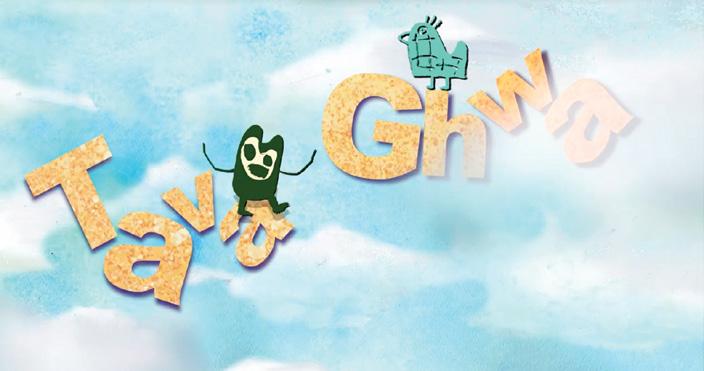
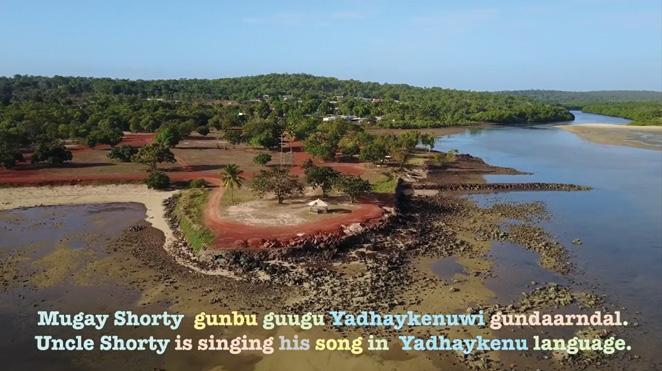
FIRST NATIONS’ STORIES BROUGHT TO LIFE IN A MULTI-MEDIA PERFORMANCE
On 13 and 20 June, locals and tourists alike, were wowed by the spectacular multi-media performance of Milbi Nguthanguthangan (Stories from a long time ago) at the Indigenous Cultural Festival in Cooktown.
For the show, Tamara Pearson of the Sacred Creations Dance Troupe brought together dozens of dance performers, many of them school students, to tell First Nations’ stories of their land, such as Nugal Warra, which recounts the creation of Birri Walmbaal (the Endeavour River). The beautiful animation, along with the performance soundtrack of Guugu Yimithirr narration and songs produced by PLC, was projected on a screen behind the dancers.
Both shows played to a packed audience, with positive feedback received from all who attended. PLC is currently collaborating with Tamara to produce a film based on the performance.


6
Cape York Institute
First Nations people unfairly shoulder a disproportionate burden of entrenched disadvantage—they are the most incarcerated people on earth, endure persistently high unemployment and the gap is not closing on health and education.
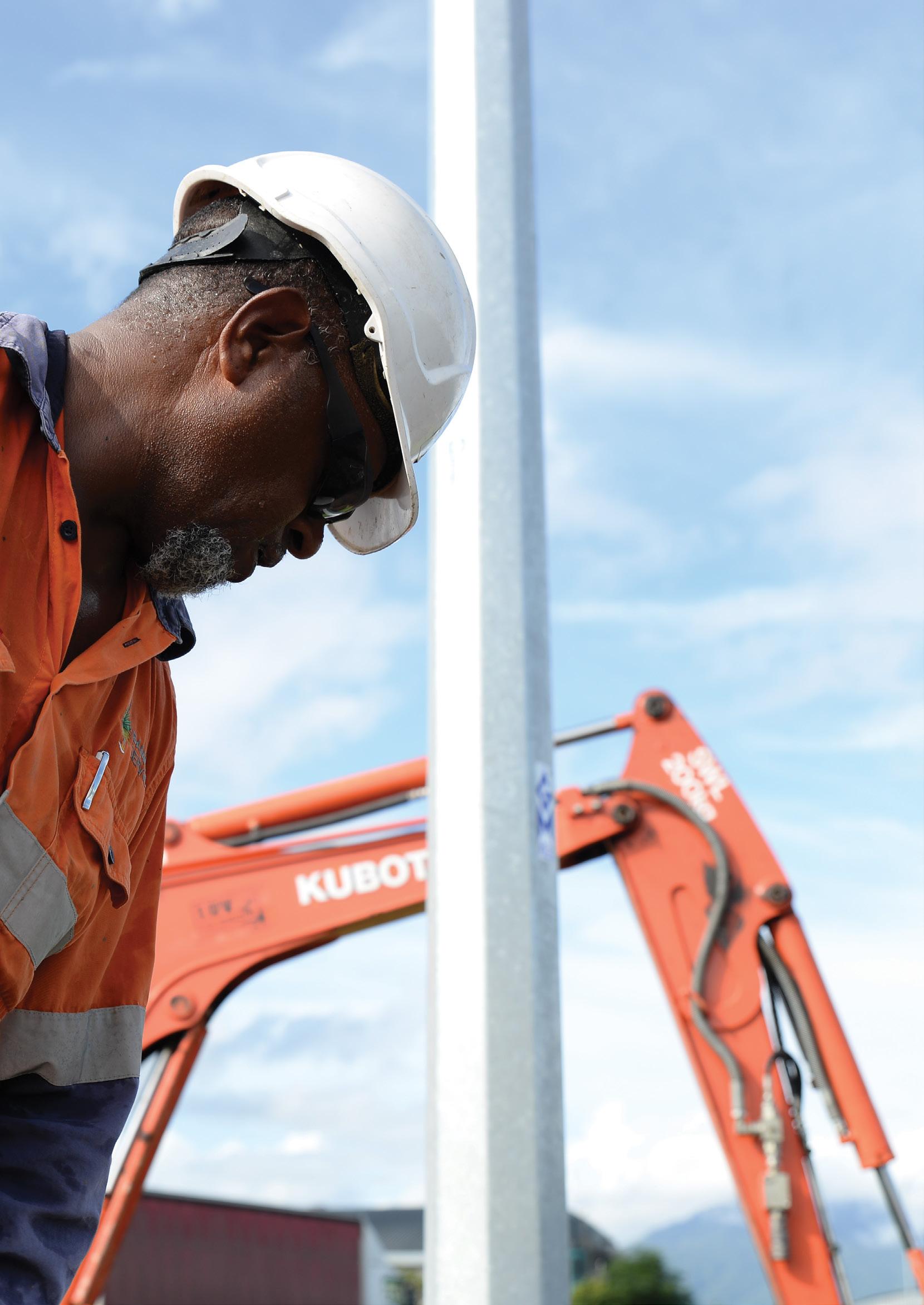
Cape York Institute (CYI) is an independent, Indigenous-led think tank that has been tackling these complex issues confronting our people since it was established in July 2004. It was initially launched as a partnership with the people of Cape York, the Australian and Queensland Governments, and Griffith University. Now, operating under the Cape York Partnership Group, CYI has continued to drive a radical reform agenda with Cape York people, whose lives and futures are at stake.
CYI’s vision and expectation for a greater more inclusive nation, and its determination to unravel wicked problems vexing Indigenous Australians, has illuminated cause, created debate, and reshaped national conversations about First Nations people. Indigenous Australians are now better positioned to be included, even empowered, to determine their own future.










